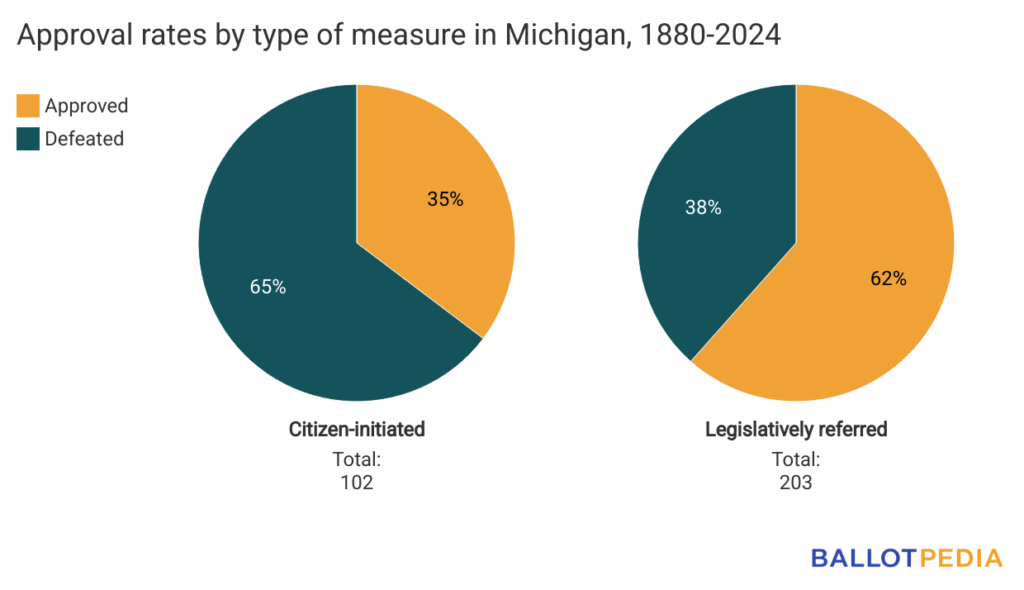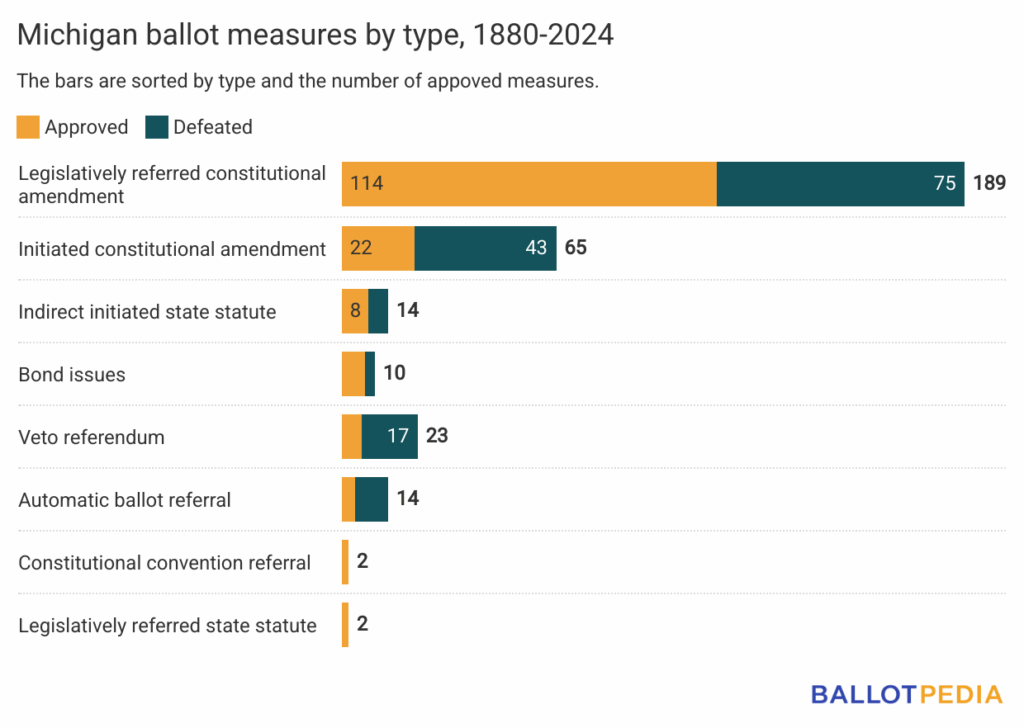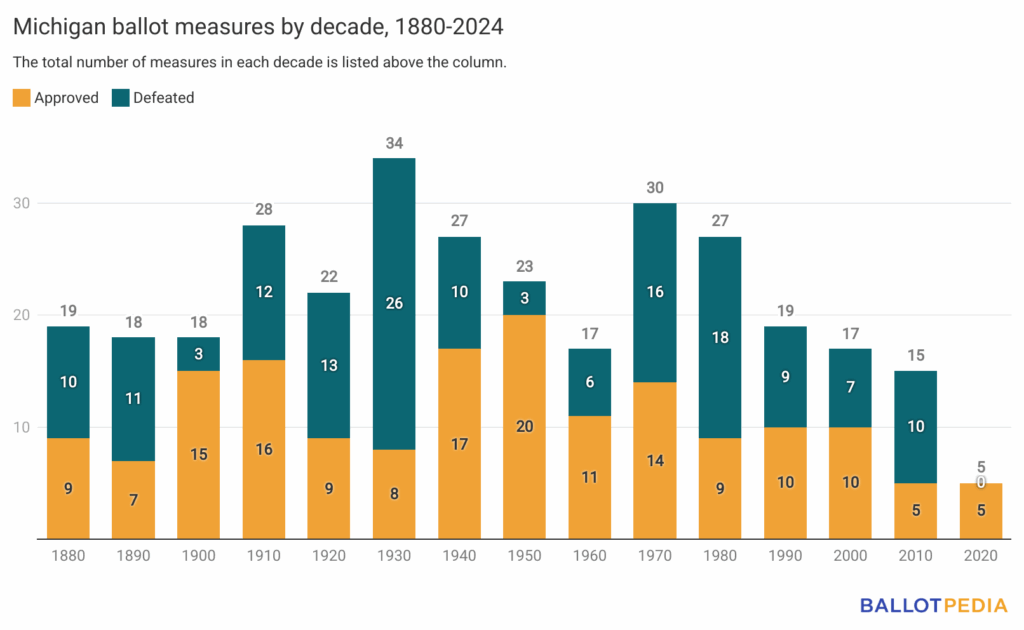Ballotpedia completed an inventory of all Michigan ballot measures since 1880. Between 1880 and 2024, Michigan voters decided on 319 ballot measures. Of these, 165 measures (51.7%) were approved and 154 (48.3%) were defeated.
In Michigan, measures can be placed on the ballot through the state legislature, as well as through the citizen-initiated process. The Michigan State Legislature referred 203 measures to the ballot since 1880, while 102 measures were placed on the ballot through a successful citizen initiative. Across time, legislatively referred measures were approved at a higher rate than citizen initiatives. Of the 203 legislative referrals, 125 (62%) were approved and 78 (38%) were defeated. Of the 102 citizen-initiated ballot measures, 36 (35%) were approved and 66 (65%) were defeated by voters.
Additionally, 14 constitutional convention questions appeared on the ballot between 1880 and 2024. Michigan is one of 14 states that provides for an automatic constitutional convention question. Placing a constitutional convention on the ballot every 16 years was established when voters approved Proposal 3 in 1960. Michigan voters will next be deciding a constitutional convention question in 2026.

There are eight different types of ballot measures in Michigan. Legislatively referred constitutional amendments have appeared on the ballot the highest number of times (203). Legislatively referred state statutes had the highest success rate at the ballot box, with all three measures being approved by voters. Veto referendums received the lowest rate of 'yes' votes among all ballot measure types, with 74% of them defeated by voters. In these measures, a 'no' vote repeals the targeted law, so the high number of 'no' votes indicates that most veto referendums successfully overturned legislation.

Michigan ballot measures addressed 132 unique topics, the most common topics being salaries of government officials (30 measures) and measures related to public education funding (21 measures).
Below is a selection of notable and unique ballot measures from Michigan’s history. For a more detailed list, see here.
- The issue of women's suffrage was on the ballot four times. The all-male electorate rejected ballot measures to grant women suffrage in 1874, 1912, and 1913. In 1918, two years before the U.S. Constitution's Nineteenth Amendment, voters approved a state constitutional amendment, with 54.1% voting in favor.
- Voters approved a new state constitution in 1908. This revision created an initiative and referendum process in Michigan.
- Voters rejected ballot measures to establish an income tax in Michigan at least six times from 1922 to 1976. None received more than 36.0% of the vote. The Michigan Constitution of 1963 allowed the state to enact an income tax but prohibited a graduated structure.
- In 1950, voters approved Proposal 3, which defined subversion, declared subversion criminal, and restricted the use of free speech or free press defenses in court cases regarding subversion. According to the Grand Haven Tribune (August 18, 1950), the constitutional amendment was designed to allow "statutes aimed at subversives and possibly to outlaw the Communist party."
- In 1972, voters approved Proposal C, a constitutional amendment prohibiting the use of public funds for non-public schools, including voucher programs. Voters rejected amendments to allow for voucher programs in 1978 and 2000.
- Voters rejected three ballot measures—Proposal D (1980), Proposal C (1984), and Proposal 5 (2012)—to require voter approval for new or increased taxes, at least in some cases.
- Voters rejected a ballot initiative, Proposal B, to allow physicians to perform abortions when a woman's period of gestation has not exceeded 20 weeks. Voters decided on Proposal B in 1972, one year before Roe v. Wade. In 1988, voters approved Proposal A, which prohibited public funds from being spent on abortions for public assistance recipients. In 2022, Michigan became the first state to approve a citizen-initiated constitutional amendment, Proposal 3, to provide for a state constitutional right to reproductive freedom.
- Michigan was the first state in the Midwest to legalize marijuana for recreational or personal use for adults. In 2018, voters approved Proposal 1, with 55.9% of the vote.
Of the 319 measures on the ballot in Michigan, seven were decided by less than a percentage point.
The measure with the closest margin was Proposal 2 in 1968, which would have exempted Michigan from observing Daylight Saving Time. This measure was defeated with 49.99% voting yes and 50.01% voting no.
The measure with the widest margin was Proposal 2 in 1881, which amended the state constitution to allow the Michigan Supreme Court to appoint its own clerk, with 90.41% of voters approving the measure and 9.59% of voters rejecting it.
The average number of measures per decade was 21, and the average number of measures approved per decade was 55%. The decade with the most ballot measures was the 1930s, which featured 34 ballot measures. Eight measures (23.53%) were approved, and 26 (76%) were defeated. The decade with the highest approval rate was the 2020s, with a 100.0% approval rate. The decade with the lowest approval rate was the 1930s.

The inventory of Michigan statewide ballot measures is part of Ballotpedia's Historical Ballot Measure Factbook, which will document nearly 200 years of direct democracy in the United States. This ongoing research effort will provide an unparalleled resource for researchers, reporters, and the voting public on how ballot measures have evolved, the issues they've covered, and the role they have played in our civic life.


